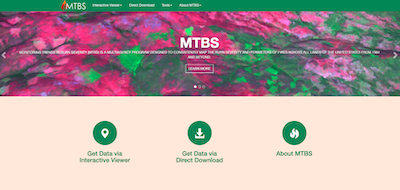Monitoring Trends in Burn Severity
Monitoring Trends in Burn Severity (MTBS) is an interagency program whose goal is to consistently map the burn severity and extent of large fires across all lands of the United States from 1984 to present. This includes all fires 1000 acres or greater in the western United States and 500 acres or greater in the eastern Unites States. The extent of coverage includes the continental U.S., Alaska, Hawaii and Puerto Rico.

The program is conducted by the U.S. Geological Survey Center for Earth Resources Observation and Science (EROS) and the USDA Forest Service Geospatial Technology and Applications Center (GTAC). The scope of the program has grown since inception and provides data to a wide range of users, including national policy-makers who are focused on implementing and monitoring national fire management strategies; field management units such as national forests, parks and other federal and tribal lands that benefit from the availability of GIS-ready maps and data; other federal land cover mapping programs such as LANDFIRE which utilizes burn severity data in their own efforts; and academic and agency research entities interested in fire severity data over significant geographic and temporal extents.
MTBS data are freely available to the public and are generated by leveraging other national programs including the Landsat satellite program, jointly developed and managed by the USGS and NASA.
MTBS data products have been utilized for a wide range of both research and operational support projects during the past two decades. They provide a unique historical record of high spatial and thematic resolution data consistently characterizing post-fire effects for documented and mappable large fires in the US from 1984 to the present.
Monitoring Trends in Burn Severity Interactive Viewer
The MTBS program was established to provide a consistent methodology to assess and document the effects of fire at a national scale. Since the program’s inception in 2005, MTBS mapping methods have evolved to accommodate changes and advancements in technology, software, satellite data and the availability of reliable fire occurrence data. It is anticipated these methods will continue to evolve into the future, however, the MTBS mapping approach has consistently occurred in five primary steps: 1. Fire Occurrence Data Compilation; 2. Landsat Scene Selection and Image Pre-processing; 3. Perimeter Delineation; 4. Burn Severity Interpretation; and 5. Data Distribution.


























